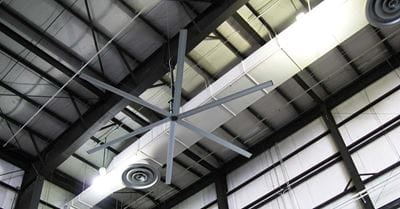HVLS Fans | Ontario, CA

For plants or warehouses, HVLS fans can have a significant influence on both heating and cooling costs and worker morale.
What Is An HVLS Fan?
An HVLS, fan, short for “High Volume, Low Speed” fan is a very large diameter ceiling mounted fan that rotates at very low speeds and distributes air through a space. They are most often added in areas with high ceilings, such as factories, warehouses, and other industrial buildings.
In summer months and warmer climates, this type of fan can help remove excess moisture from the atmosphere by substituting hot, humid air with drier air. During the winter, they can also help manage temperature by fully circulating warm air through a facility.
HVLS Fan Size
HVLS fans are a minimum of 84 inches across. Some fans can be as much as 24 feet across, although for most commercial uses several smaller fans are used. Fan output varies, but most are between five eighths and one horsepower.
Although almost all HVLS fans are meant to be mounted on ceilings, a few specialty fans can be designed to attach to floor mounted poles.
How Do HVLS Fans Work?
HVLS fans are effective because of their low RPM and enormous scale. HVLS fans generate massive columns of air that proceed at low speed, as opposed to the fast-moving, small scale air currents that are produced by standard fans. Tumultuous, rapid airflow from typical fans creates friction against static air and velocity rapidly dwindles.
With large-scale fans, the massive air columns travel slowly and go greater distances because there is far less air friction. Consequently, it requires less energy to force greater portions of air at a slower rate than is needed to move lesser volumes of air at a quicker speed.
The disparity in energy usage is remarkable. It takes nearly 27 times more energy to move air at 6 miles per hour versus moving air at 2 miles per hour. The bottom line is this: you're much better off running larger fans a very low speeds versus smaller fans at high speeds.
Warehouse HVLS Fan Benefits
Reduce Heating Costs
During the winter months, a single HVLS fan can contribute significantly to energy cost savings.
Large buildings, especially those with high ceilings, naturally stratify air by temperature. Warmer air moves to the ceiling while cold air remains close to the floor. Heaters must work overtime to warm the space near the ground, which is expensive, while the majority of that warm air moves toward the ceiling, away from workers.
Using an HVLS fan pulls a large volume of heated air away from the ceiling, assisting in recirculation throughout the facility, thereby balancing the temperature and enabling the HVAC system to work more efficiently.
Reduce Cooling Costs
Although HVLS fans are great at balancing heat recirculation in a building, the opposite is also true: they can assist with air conditioning in the summertime or in regions that are consistently warmer.
The fans keep air moving around large spaces, and this airflow generates an evaporative cooling response. Although the fan does not actually alter the temperature of the circulating air, it will evaporate much of the inherent humidity in the air, creating a more comfortable environment.
Reduce Environmental Impact
Although saving money on energy expenses is a great incentive, there is the added benefit that reducing energy consumption also shrinks a business’ carbon footprint. Over months and years, HVLS fans can deliver substantial reductions in energy use, particularly for operations with multiple locations.
Enhance Employee Comfort & Productivity
Content workers are typically more effective, so maintaining your buildings at optimal temperatures is advantageous. Several studies have identified a correlation between extreme temperatures and reductions in productivity.
HVLS Fans For Sale Near Me
If you’d like to learn more about the advantages of HVLS fans for your warehouse or industrial operation, call a warehouse consultant at Raymond West today.
Raymond West's Ontario, California facility serves parts of Los Angeles County and San Bernardino County, including Ontario, Fontana, Rancho Cucamonga, Upland, La Verne, San Dimas, Covina, West Covina, Pomona, Diamond Bar, Rowland Heights, Chino, Norco, Eastvale, Corona, Jurupa Valley, San Bernardino, Rialto and all surrounding areas.
Raymond West | Ontario California Material Handling Equipment Supplier
4602 E Brickell St
Ontario, CA 91761
(909) 930-9399

